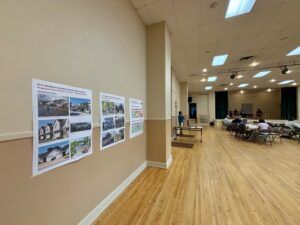
by Nathan Boddy
Since the adoption of a new comprehensive plan in 2022, the City of Hamilton has turned attention to the updating of its zoning code. A zoning code works in tandem with a comprehensive plan to put into action a municipality’s plan for the future. Hamilton’s comprehensive plan included the themes: grow in a proactive and thoughtful way, and maintain small town character. But whereas a comprehensive plan includes those more generalized vision statements, a zoning code is meant to put those desires into action through specific allowances and on-the-ground regulations.
The existing zoning code in the City of Hamilton has not been substantially updated in nearly 20 years, and city staff, along with a focus group comprised of volunteers, interested citizens and members of the three planning related boards in Hamilton (Zoning Commission, Planning Board, and Zoning Board of Adjustment), have been working to identify elements which may be appropriate for a newly updated code. The current zoning code update began in earnest in the fall of 2023, and is now within its second phase after staff completed a reorganization of the zoning code, making it easier to use and eliminating redundancies.

Hamilton planners, Matthew Rohrbach and Mark Rud, have been compiling potential changes to the zoning code, and asked the public for input during two open house meetings on September 18th and 25th, and four walking tours on September 19th and 26th, for the purpose of showing how code regulations take shape on the ground. During those events, attendees were given handouts detailing proposed regulation changes which deal with the residential areas within Hamilton city limits, and presented visual aids as to what housing types could be permitted within each of the proposed zones.
Among the proposed changes, planning staff has suggested re-creating the existing residential zones RS, RM and RH, into R1, R2 and R3 respectively, with R1 standing for Traditional Neighborhood, R2 as Medium Density and R3 being High Density. A chart detailing proposed allowable housing types was also displayed for attendees to consider. Without dispute, the proposed zoning code would substantially increase the number of allowed housing types, but does set lot size minimums for multi-family units as well as size and setback requirements for each.
During the open house events, Rohrbach and Hamilton Mayor Dominic Farrenkopf fielded questions about the proposed zoning code update, and the steps they are taking to usher it forward. Within the council chambers where the open house meetings took place, visual aids and housing type charts were hung on the walls for the public to consider.
“It’s going to be a multi-year process to do the whole zoning code overhaul,” said Rohrbach. “We are being very slow and deliberate on purpose.” Both he and Mayor Farrenkopf specified that they want the process to be as transparent as possible, giving the community a chance to weigh in. Furthermore, Rohrbach expressed on several occasions that the code update language they were presenting was still in draft form, and meant to garner feedback and see which elements would stick, and which would be abandoned.
One of the many topics that illustrated a potential change within the new zoning code would be how administrators are able to deal with non-conforming uses. Non-conforming uses are those that exist under ‘grandfathered’ status, but are not permitted to be expanded or replaced if substantially damaged. Under the draft language, the city’s Zoning Administrator would be able to distinguish between ‘benign’ non-conforming uses and those that may pose a risk to public safety and welfare. Where a use is determined to be benign, it may be eligible for limited expansion, alteration or replacement, without first undergoing a variance process.
Rohrbach mentioned the non-conforming use clause when the subject of affordable housing was brought up during the meeting. He said that ,“a key reason for changing those nonconforming use regulations was in relation to mobile homes,” which often exist as non-conforming uses. The changes in language, he asserted, are done not just in the spirit of getting more affordable housing on the market, but also to preserve the stock that currently exists.
But some of the proposed language is directly aimed at development of more attainable housing. During a walking tour on September 26th, Rud told attendees that the “biggest change is in the ‘by right’ category,” by which he meant those types of housing that would expressly be allowed per the zoning code. The housing types in an R-1 (Traditional Neighborhood) district, for example, could include higher density structures, up to a four-plex multi-family unit where lot size is over 8,000 square feet. Rud pointed out that such allowances represent a “pretty substantial change.”
In addition to increasing the allowed housing types within residential districts, the proposed zoning code would allow for certain setback standards to be loosened for qualifying higher density housing types. For example, front yard setbacks for single family homes and duplexes in the R-1 zone would be 20 feet, while those for 3- and 4-unit buildings would be lessened to 10 feet.
Rohrbach said that part of the rationale behind allowing for a lessened setback on higher unit buildings is so that such buildings are able to provide parking at the rear of the lot, but he also pointed out that the planning department’s efforts are in response to a call for increased housing in Hamilton. The challenge, he stated time and again, is to balance that need for housing with the Comprehensive Plan’s stated goals of ‘maintaining a small town character’ and preserving the form and scale of existing neighborhoods.
Jessica Randazzo, who serves on the city’s Zoning Commission, was present on the walking tour and expressed concern with varying setbacks to incentivize density. She said that, when used to “make space more livable,” she was “all in” on requiring setbacks of a certain depth. However, she expressed that she didn’t want to see certain housing types punished when others get a “reward.”
Rohrbach responded to her concern by saying, “You could look at it as punishing the single family home and a duplex because they do have a higher standard, or you can look at it as trying to make an exception for those different kinds of units to make it easier for them to be filled so we can achieve that housing production.”
To review all draft zoning code documents, leave feedback and keep up to date, visit the city’s page dedicated to the process at: https://www.hamiltonzoningupdate.com.
Hobo Hilton says
Question:
Do any of the folks named above have a Master of City Planning (MCP) degree ?
If not… Why not ?
Hobo